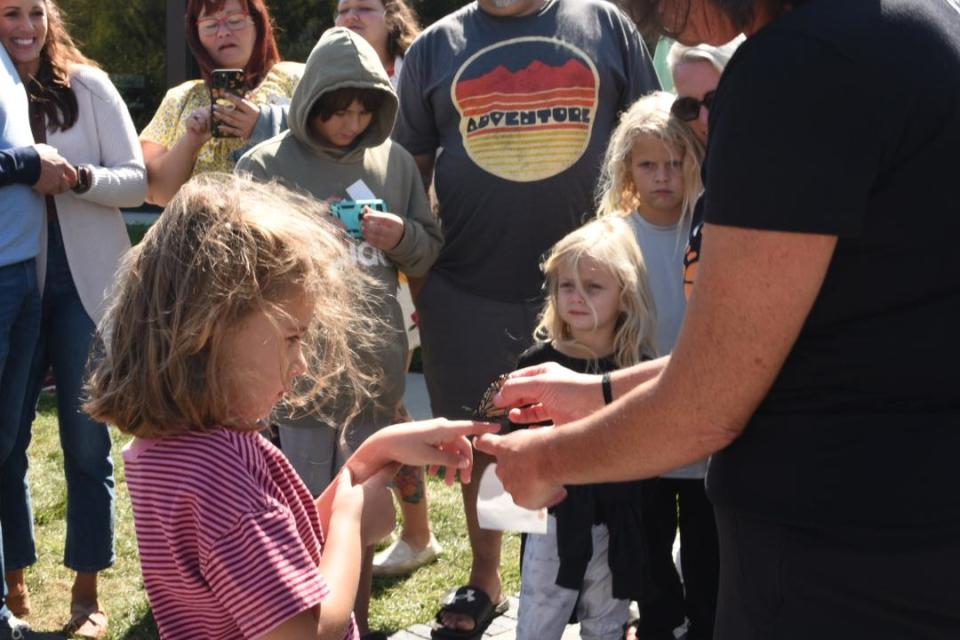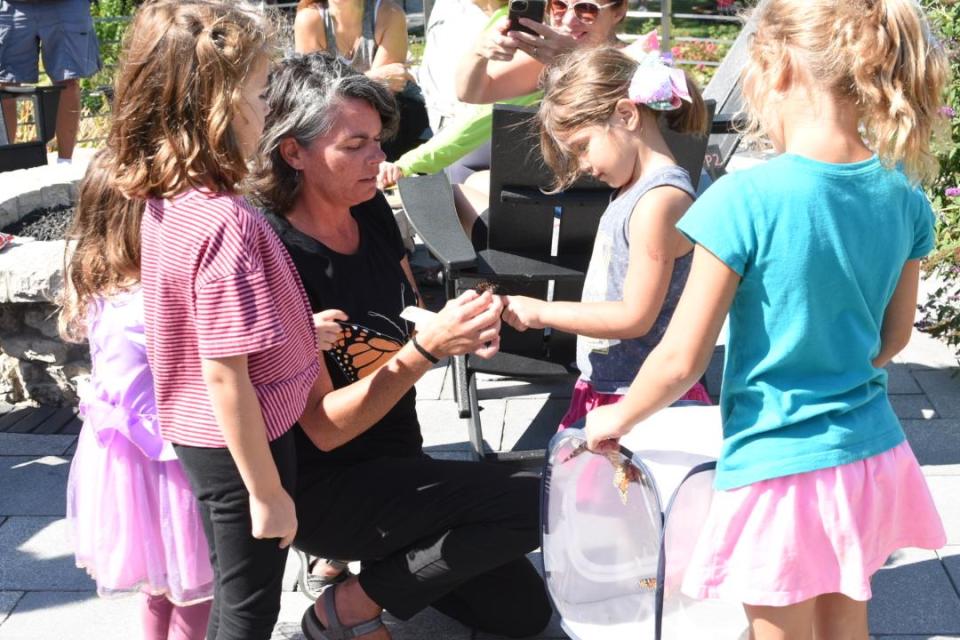Twin Oast hosts monarch butterfly tagging event
PORT CLINTON - Eager children and adults alike got an up-close look at monarch butterfly tagging and releasing with a biologist at a free event at Twin Oast on Catawba Island on Saturday, just after peak migration.
Jackie Taylor, a biologist with the Kelleys Island School who also partners with Stone Lab on South Bass Island, talked to the crowd of about 30 to 40 people of all ages about monarchs' lifecycle, how she became involved in tagging them and then taking 14 she had captured outside the brewery to tag and release for their long journey to Mexico.

Taylor has been working since 2011 to capture, tag and release monarch butterflies in the Lake Erie Islands.
Monarchs are found in 90 countries around the world, she said. Their lifecycle is just a few weeks, unless they are the generation that flies south for the overwintering.
Taylor specifically follows those in North America, and those east of the Rocky Mountains, the largest population.
There is a small population in Florida and in the Carolinas that do not migrate due to warmer temperatures. They are now overwintering there, Taylor said.
But mostly populations from Canada and the United State fly south, stay on Pelee Island in Lake Erie, then wait for a warm, sunny day and continue south to the U.S. side of the border, stopping on Kelleys and the Bass islands in Lake Erie, using them as "steppingstones" on their journey.
Monarchs fly 50 to 100 miles a day
"They fly about 50 to 100 miles a day," Taylor told the crowd.
Monarchs then fly south to the Sierra Madre Mountains in Mexico, flying thousands of miles over all sorts of terrain to reach their final destination.

The Sierra Madre Occidental is a major mountain range system of the North American Cordillera, that runs northwest–southeast through northwestern and western Mexico, and along the Gulf of California.
Outside on the patio in the warm sunshine, Taylor and about a dozen curious children tagged the captured monarchs and released them, watching excitedly as they fluttered in the northeast winds.
The tags are the same used on fresh fruits and vegetables you find at the grocery store and will stay on the butterflies past death, she said.
Researchers use data from tags
Researchers in Mexico record data and relay information on where they were found for those who have tagged them.
In the 10 years she's been tagging monarchs, 11 have made it to Mexico.
Emerson Mayes, age 5, of Mars, Pennsylvania, who was visiting her grandparents, Paul and Alison Perlaky of Catawba, was one of the children who helped Taylor hold the mesh container with the monarchs and helped release a few herself.
"It tickled," Mayes said of feeling the butterflies' tiny feet on her hand.

Holding them was her favorite part, she said.
Together Taylor and volunteers tagged and released six males and eight females.
Unfortunately for the monarchs, 2023 has been a very low year for migration, the lowest since 2014, Taylor said.
"I usually tag over 100 in a year, this year I've only gotten 50," she said.
But Taylor encouraged the crowd to look for ways to help and continue learning about monarchs and the critical role they play in our ecosystem.
Ways to help the monarch butterfly
Classified by some organizations as endangered, monarchs are just a candidate for an endangered status with the U.S. Fish and Wildlife Service. They can be found in almost every state in the U.S. but not in Pacific Northwest, because there is no milkweed, which they depend on.
Along their migration routes in the U.S., the monarch female seeks milkweed plants, upon which she deposits her eggs. Milkweeds, or plants in the Asclepias genus, are the exclusive host plants for monarch butterflies. Monarch caterpillars will feed and survive only on plants in the Asclepias genus.
According to prairienursery.com, a 100-square foot garden is a good size for monarch support. Alternatively, a few well-chosen native plants may be added to an existing garden. The top three elements needed for a monarch waystation are:
● Location — A good butterfly spot receives 6 hours or more of full sun a day. Ideally, the location will give shelter from the wind as well. The sunny side of a garage or along a solid fence in the sun offers enough protection. Any well-drained soil is acceptable.
● House plants — Include at least two species from the Asclepias genus (milkweed or butterflyweed) for host plants. Plant a group a of each species. For example, a group of three butterfly weed plants, plus a group of five Sullivant's milkweed plants. The Asclepias species that is selected will depend on the soil:
Dry Sandy soil: Butterflyweed, whorled milkweed, showy milkweed, common milkweed.
Loamy soil: Sullivant’s milkweed, butterflyweed, whorled milkweed, showy milkweed, common milkweed, red milkweed.
Clay Soil: Butterflyweed for clay, showy milkweed, common milkweed, Rrd milkweed.
Moist Soil: Common milkweed, red milkweed.
● Nectar Plants. Adult monarch butterflies need nectar from a variety of native plants. The nectar provides energy to the adult butterflies and fuels their flight. Fall-blooming natives such as asters and goldenrods are very important. The monarchs need as much fuel as they can get on their long flight back to Mexico in the fall.
This article originally appeared on Fremont News-Messenger: Twin Oast hosts monarch butterfly tagging event to study migration

